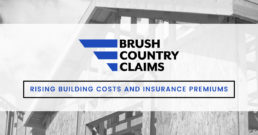Rising Building Costs and Insurance Premiums

How the Rise of Building Costs is Impacting Home Insurance
In the first half of 2021 we have seen a rapid increase in the price of materials needed for construction. What is responsible for the rise in the price of building materials? How are the rising building costs impacting home insurance premiums?
Data suggests COVID-19 lockdowns redirected personal funds that would typically have been spent on vacations and recreation to home improvements and home purchases. Last year was also an above average year for catastrophes, adding to elevated consumption of construction materials and labor.
Historically low interest rates further incentivized new construction and remodeling projects. The cumulative result has been a staggering rise in demand for building materials, particularly lumber and plywood.
This sharp increase in demand coincided with a severe crimp in the supply chain of wood products. The mid-2000’s real estate crash exposed an oversupplied market and countless mills and production facilities went out of business.
The Impact of COVID-19 on the Construction Industry
The suppliers that remained have been the victims of pandemic restrictions that forced many to shut down or operate at a more limited capacity.
Mills that are now trying to increase production are finding it difficult to hire new workers because of unemployment bonus payments, a reduction in rural population, and a general trend away from blue collar occupations as educators push college for all.
Truck drivers are also in short supply across the economy, vital to production as they move logs from forests to mills and get finished products to distribution centers. Suppliers were not prepared for the sudden and intense surge in demand and with a 2-year lead-time to construct a new mill it will be a lengthy road to catch up.
Inflation and the Increase of Demand for Lumber
The Consumer Price Index in April of 2021 revealed an increase of 4.2%, indicating things are getting more expensive for Americans, including fuel, grocery, and construction costs. This was the biggest increase since 2008. Adding these inflationary effects to the sharp increase in demand, decrease in supply, and residual 9% tariffs on Canadian lumber, we have seen the price of building materials triple, adding $36,000 to the average cost of building a house according to the National Association of Home Builders.
Building materials have become such a hot commodity that they are being stolen left and right! Theft reports from job sites have drastically increased. Some independent builders, who lack the scale advantages of the larger construction companies, are really feeling the pain. Some report experiencing six figure Theft losses over the past year.
According to Zillow, the average US home price in January of 2021 was $269,039. Reconstruction costs, which are typically less than market value, have increased around 13% over the recent months with the spike material costs. If you are a homeowner, you should consider the insurance implications here and take the steps necessary to be certain that you are adequately indemnified in the event of a loss.
If you added a room, constructed a deck, remodeled a kitchen, built that ‘she-shed’, or performed any other home improvements that would increase the reconstruction value of your home, this needs to be communicated to your insurance professional. You may need increased limits to ensure your coverage is sufficient.
The Impact of Reconstruction on Home Insurance
Higher limits will likely result in slightly increased insurance premiums and, if you have a percentage deductible, will result in higher per claim financial participation for you. Insurance companies, in anticipation of increased claim expenses, may also elect to increase premiums across the board to maintain desired loss ratios. The insurance carrier will experience higher claims indemnification costs as well as loss adjustment expenses because of higher estimates from adjusters and contractors.
Now is an excellent time to review your coverage levels. Verifying that you have the appropriate “insurance to value”, valuation method, and coverage endorsements, can protect you from financial devastation if you have inadequate limits or narrower than anticipated coverage in your policy. If you have not, a meeting with your agent to get a full understanding of your limits and coverage would be a great idea.
Pro Tip: Protect your property with measures to avoid losses anywhere you can. The biggest risk to homeowners, in terms of frequency and potential severity of damage, are water losses. The primary sources of water losses are plumbing system failures. To prevent water damage, inspect and replace any parts in your plumbing-supply system that show signs of wear and tear.
You can go even further and consider water leak detector systems with sensors that alert you the instant an escape of water is detected. It is worth checking with your insurance professional to see if there could be premium savings or other incentives if you have these smart sensors installed, like those offered by Roost Home Telematics.
The Future of Supply and Demand of Building Materials
What will the future hold? Lumber hit a record high of $1,670 per thousand board feet in May, but July futures are down to around $996.20. This is a 40% drop from May’s record highs.
This is not yet, however, a signal of reduced demand or increased supply. High price volatility leads to large moves like this in wood products because demand on materials moves much more freely and quickly than sawmill capacity can.
Eventually though, the majority of those that could take advantage of lower mortgage rates will have done so and unaffordability will bring demand back down to earth. Supply will catch up to demand and most Economists anticipate prices to decline sharply in the next 18 months, returning to near “normal”, pre-pandemic levels by 2023.
Until prices return to normal levels the higher cost of building materials that factor into construction or repair projects will be passed on to us, the consumer. This is high on the minds of many considering building, purchasing, or renovating a home. However, we should also keep in mind the impact that elevated reconstruction costs have on property insurance, the insurance consumer as well as the insurance carrier.
This article was written by Kevin Myers, MBA, CPCU, ARM, AIC, Chief Executive Officer of Brush Country Claims.
Click here to view more of Kevin’s content on LinkedIn

About Brush Country Claims
Brush Country Claims is an independent adjusting firm that offers a full claims solution for residential, commercial, daily, and catastrophe claim management. Brush Country utilizes an innovative suite of proprietary technology to maximize customer experience while consistently having some of the fastest cycle times in the industry. A human led, tech forward approach embraces the grassroots beginnings of the company as well as their incredible drive to propel into the future.
Related Posts
July 28, 2021
PRESS RELEASE: Lloyd’s Lab Pitch Day
GEORGETOWN, Texas – July 28, 2021 – Brush Country Claims, a Central Texas-based…
July 12, 2021
Get to Know our CAT Team Leaders
With hurricane season upon us, we wanted to do a little Q&A with our CAT team…
June 24, 2021
The Benefits of Remote Work
Healthy culture = healthy employees. We’re proud to say our team at Brush…



